It’s almost August, and the heat is still intense. Time to take another glance out the window and then go back to playing video games. This month’s Roundtable has a ton of classics and some neat ones you might have missed, so stay inside where it’s cool and check them out!
Thunder Fox By Ken Horowitz
I sure do love those Taito coin-ops of old, especially those that had two-player options. Going through a game with a friend is always better than going it alone, and Thunder Fox was a great way to have some action-packed fun. I have fond memories of playing it in the arcades, so naturally I was looking forward to the Genesis port.
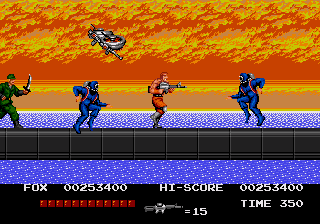 This is the part where you’re probably expecting me to mention that I was disappointed by the home version because it was watered down or just not the same… whatever. While the differences are apparent to anyone with a decent set of eyes, and though I am ready to concede the poor work done on this port, that’s not what really boils my blood. No, what I find most inexcusable is the omission of the two-player mode. So, in addition to all the game’s other faults, the single best thing that made it great is also gone. Thanks Taito!
This is the part where you’re probably expecting me to mention that I was disappointed by the home version because it was watered down or just not the same… whatever. While the differences are apparent to anyone with a decent set of eyes, and though I am ready to concede the poor work done on this port, that’s not what really boils my blood. No, what I find most inexcusable is the omission of the two-player mode. So, in addition to all the game’s other faults, the single best thing that made it great is also gone. Thanks Taito!
After reviewing Thunder Fox, I figured that I’d probably never play it again and just stick to the original on MAME. However, while going through my Genesis collection for something to play last weekend, I figured I’d give it another shot. Needless to say, I’ve since learned a thing or two about second chances…
Sensible Soccer By Sebastian Sponsel
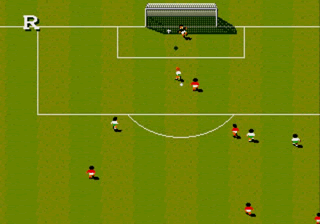 So, the World Cup has concluded, Germany reached the semi-finals (once more), and Spain has become World Champion for the first time. So do we have to wait another four years to enjoy our games of football? Well, do we always need the newest console to enjoy our video games?
So, the World Cup has concluded, Germany reached the semi-finals (once more), and Spain has become World Champion for the first time. So do we have to wait another four years to enjoy our games of football? Well, do we always need the newest console to enjoy our video games?
Sensible Soccer might not be the most realistic soccer game out there, far from it. It doesn’t sport the best graphics, sound effects and music are minimalist even compared to contemporary games. But the fast-paced gameplay and easily accessible controls, combined with a very loose set of rules, packs a ton of fun even today.
Who says you need great graphics? Who says you need ultra-realistic gameplay? This one is all about fun! Graphics get old, but well put together enjoyment lasts forever.
Clay Fighter By Jackie Bogard
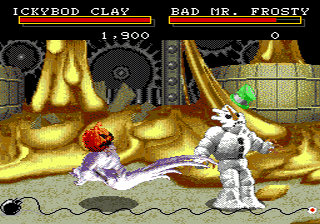 Well, what a month, been mostly playing SSF4 on the 360, but I did manage to slip in some quality genesis time. and why not keep the fighting games going? I tossed the Clay Fighter cart into my console, already knowing the game is lacking badly. but, after a few annoying play problems (slow, bad collision detection on hit boxes..etc). but after a few rounds I started to enjoy myself a bit, the unique roster is always fun to see. Bad Mr. Frosty… good stuff. but I used taffy, because… he’s taffy, I guess.
Well, what a month, been mostly playing SSF4 on the 360, but I did manage to slip in some quality genesis time. and why not keep the fighting games going? I tossed the Clay Fighter cart into my console, already knowing the game is lacking badly. but, after a few annoying play problems (slow, bad collision detection on hit boxes..etc). but after a few rounds I started to enjoy myself a bit, the unique roster is always fun to see. Bad Mr. Frosty… good stuff. but I used taffy, because… he’s taffy, I guess.
The play through was pretty easy after I got the controls down, and my son seemed to enjoy watching me play through it, as he sat and watched the whole thing. The only annoying thing that I didn’t and still don’t understand, why is it that I have to fight some characters twice, but not others? I don’t understand, maybe they where more powerful the second time? no idea. the game was a basic walk in the park, and the last boss only doing projectiles was a bit cheap, but I got around it.
But all in all, the game isn’t worth a whole lot of money, $2 dollars max loose I would say. the animation is so so, but the clay look is fun to see. and just for the silliness of it, it was worth the play through.
Spider-Man & Venom: Maximum Carnage By Greg Jurkiewicz
Spider-Man and Venom: Maximum Carnage is my favourite beat-’em-up and I swear I will fight to a bitter cartoonish death to defend this game. As far as gameplay in brawlers goes, this game is the smoothest I’ve ever seen. It plays a bit better on the Genesis than it does on the SNES with faster gameplay and more responsive controls. The hit detection in this game is immaculately accurate and the enemy AI actually requires you to use your entire arsenal of attacks.
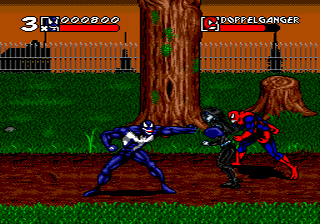 Now, what really gets me about most criticisms of this masterpiece is when people accuse it of having limited or boring combat. While most brawlers usually feature a limited list of five or six moves along the lines of: punch, grab, jump kick, throw and special move, run if you’re lucky… Max Carnage has a repertoire of twenty-two moves! (punch, grab punch, lift+throw, lift+spin+throw, jump kick, flying kick, spin kick/tornado punch, drop kick, back flip, run, shoulder check, web pull, double slam, web restrain, web bullet, web sling, web sling kick, wall climb, wall punch, web hang, block, call help) You’d think with so many moves it’d be hard to perform them, but it really isn’t. The controls are beautifully intuitive, to the point that all those moves make the combat better than most fighting games.
Now, what really gets me about most criticisms of this masterpiece is when people accuse it of having limited or boring combat. While most brawlers usually feature a limited list of five or six moves along the lines of: punch, grab, jump kick, throw and special move, run if you’re lucky… Max Carnage has a repertoire of twenty-two moves! (punch, grab punch, lift+throw, lift+spin+throw, jump kick, flying kick, spin kick/tornado punch, drop kick, back flip, run, shoulder check, web pull, double slam, web restrain, web bullet, web sling, web sling kick, wall climb, wall punch, web hang, block, call help) You’d think with so many moves it’d be hard to perform them, but it really isn’t. The controls are beautifully intuitive, to the point that all those moves make the combat better than most fighting games.
The only downside to this game is the lack of two-player mode. Although given the storyline it would have been really be hard for them to work two-player action into the game from the start. Remember, when the Max Carnage saga begins Spidey and Venom are still bitter enemies and are only united under a common goal about halfway through the plot. Introducing two-player gameplay halfway through would’ve been odd and starting the game at the point in the story would’ve been a mess of unexplained plot points. So really, I can forgive the lack of two-player mode, plus this way it allows for bigger sprites, which is pretty awesome, as awesome as the red Sega cartridge.
Madden ’94 By Steven Campbell
Man, I am ready for football season. Sundays here in Texas just aren’t Sundays without some good ol’ hand egg on the tube whilst cleaning house, doing laundry, and getting prepared for the long week of ropin’ steers, and herdin’ cattle that all of us Texans do every day. Usually, from February up until August I personally get my pigskin fix on the all-mighty “blast processor,” and if you’ve checked the budget bin of your local retro game shop recently you’ll know that there are almost literally a ton of football games to choose from during my off season.
William Robinson (Red Dead Redemption) and High Score Entertainment took over development duties of the franchise with Madden NFL ’94. The result is a really good game, even better than Visual Concepts SNES version of ’94. Most retro game enthusiasts/collectors consider ’94 the pinnacle of the Madden series on the Genesis, but if you look a little closer you’ll see that while taking big steps forward with the bigger, better animated player sprites and features, the game also took a few steps backwards in other departments.
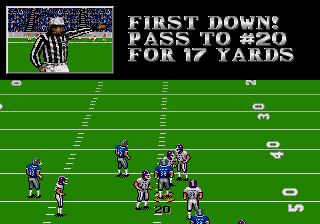 One of the things that gets on my nerves is the minor sprite flicker around the line of scrimmage, and in certain colored end zones. The bigger player sprites tend to slow the game down at certain times during gameplay, and they cut corners with the team colors as well. Some teams were only given a two tone color scheme (Oilers), much unlike the previous Jim Simmons/Park Place ’92 and ’93 versions of the game, where each team’s colors were surprisingly accurate considering the fact that they were risking getting sued by the NFL due to the lack of a license for their brand. Madden ’94 brought in the NFL license as well as finally adding the season mode, long after Tecmo Super Bowl, and Sega’s Joe Montana franchise.
One of the things that gets on my nerves is the minor sprite flicker around the line of scrimmage, and in certain colored end zones. The bigger player sprites tend to slow the game down at certain times during gameplay, and they cut corners with the team colors as well. Some teams were only given a two tone color scheme (Oilers), much unlike the previous Jim Simmons/Park Place ’92 and ’93 versions of the game, where each team’s colors were surprisingly accurate considering the fact that they were risking getting sued by the NFL due to the lack of a license for their brand. Madden ’94 brought in the NFL license as well as finally adding the season mode, long after Tecmo Super Bowl, and Sega’s Joe Montana franchise.
One thing I don’t understand is why they couldn’t keep the individual stat tracking from ’93 for the new season mode? The season is pretty lame without any stat tracking. I’ve been playing a season with the Oilers for the last month, which I went 16-0 and ran through the playoffs with ease. I would’ve loved to have seen what kind of ridiculous numbers I had put up throughout the 16+ games with Warren Moon.
After playing this game so much recently I’ve come to the conclusion that it is not as good as Madden ’92 and ’93, even with the season mode and NFL license. Those games had better colors and collision detection, not to mention ’93 had individual stat tracking throughout the playoff tournament. ’92 and ’93 were also free of the slow down, and minor sprite flicker that plagued the ’94 game. If you look a little bit closer, Madden NFL ’94 was a bit of a rough start for William Robinson & High Score Ent., and personally I don’t think they ever really captured or topped what was done with Madden 92 and 93. If you ask me, I don’t think it gets any better than Jim Simmons’ ’92 Genesis exclusive version of the game when it comes to which is the best Madden on the best console for football games ever made.
Castlevania Bloodlines By Chris Leathco
One of the things that’s awesome about being a retro gamer is discovering titles you missed out on in your childhood. Games you have no clue how you missed out on, but you can greatly enjoy even though you’re late to the party.
This week, I played Castlevania Bloodlines for the first time. And its absolutely fantastic. A lot of people online compare it to Castlevania IV, saying that the Genesis Bloodlines is a weaker game. I feel that’s rather unfair, as both games have their benefits.
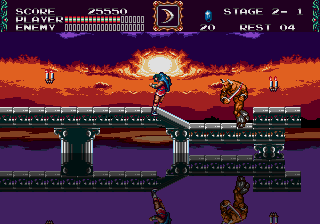 The first thing that was surprising to me was a character select screen. This was the first (perhaps only) Castlevania game to allow you to choose a character, and both characters perform differently, which gives the game extra replay value. So after just pressing one button, the game has features that no Nintendo system ever had. Than the game begins, and we see what Nintendo had been protecting our young, virgin eyes from: blood and gore! Torn bodies, spurting enemies, this was a great change of pace from the SNES Castlevania IV, which felt more “spooky” compared to Bloodlines being more “brutal.” Looking back, Bloodlines was the perfect subtitle for this game.
The first thing that was surprising to me was a character select screen. This was the first (perhaps only) Castlevania game to allow you to choose a character, and both characters perform differently, which gives the game extra replay value. So after just pressing one button, the game has features that no Nintendo system ever had. Than the game begins, and we see what Nintendo had been protecting our young, virgin eyes from: blood and gore! Torn bodies, spurting enemies, this was a great change of pace from the SNES Castlevania IV, which felt more “spooky” compared to Bloodlines being more “brutal.” Looking back, Bloodlines was the perfect subtitle for this game.
The bosses are cool as well. The zombie-dog thing at the end of the first stage was neat to look at, but than the battle took an interesting turn as his howl destroyed the glass windows behind the battle area, and the glass shards could damage our hero! Pretty cool use of the environment to bring you a little deeper in the game, something that not many games tried back in this era.
The music blew me away too. I’m used to the SNES music being better than the Genesis, but the music in this one rivals its competition for once. Nicely done.
The only real downer is that it ends so soon. six stages and its over. I wanted more, and its a shame we never saw another 16-bit era Castlevania on the Genesis. But that’s a small gripe for such a great title. This makes a great companion game to Hard Corps, be sure to play ’em both, and have yourself a Konami Genesis gaming session to play these franchises born on the NES, but injected with Sega attitude!
Road Avenger By Sean Barnham
People talk a lot about defining moments in video game history. They bring up the epic storyline of Final Fantasy VII, the addictive qualities of Tetris (and its music) and even our own Green Hill Zone.
Not me.
But what could possibly be more important than spiky-haired Lego people trying to save the Earth, Russian mind-control plots and blue hedgehogs fighting robot wasps?
The answer is Road Avenger… or rather the theme to Road Avenger by “me neither” Japanese soft-rock band J-WALK. From the opening line (“Ah know ah‘m gawna re-vah-ve when ah ayum… awn the rowad”) to my personal favourite – “I know too well eeh‘s berry hurd, eeh‘s jes burkeng for dee seelbah moo-oon” – the song has absolutely everything. I feel that it sums up the game very well. You almost don’t need to play the game if you listen to the song, but you should anyway.
 Yes, you can complain that the video is grainy or that the gameplay is repetitive and maybe even that the animation kind of sucks, but you cannot deny that the game has charm. It manages to be exciting because it is FAST – just like driving a car! You never know when you might have to turn left, brake, accelerate or even turn right!
Yes, you can complain that the video is grainy or that the gameplay is repetitive and maybe even that the animation kind of sucks, but you cannot deny that the game has charm. It manages to be exciting because it is FAST – just like driving a car! You never know when you might have to turn left, brake, accelerate or even turn right!
There’s more to it than that though. Road Avenger is every car chase ever filmed since Starsky and Hutch. It has all the components of a great action movie without all of that tedious “story” which is always getting in the way. All you need to know is that a gang of street punks (with helicopters) run your car off the road, killing your wife but leaving you unscathed. Naturally, you decide to get your extra car (oh, that one) and drive it into lots of other cars. The title says it all.
The thing about Road Avenger is that you accept things which would be ridiculous in a film, the difference being that you don’t have time to laugh because then you’ll forget to turn right and then you die (find the death scenes on YouTube, it’s worth it). You drive your way through several hotels, leap over cows, dodge flying boats, fly into helicopters (they blow up in mid-air but you are fine. Why? Because… don’t ask questions, that’s why) and chase motorbikes up stairs. I don’t know about you, but I think that’s pretty cool.
Something which you also begin to realise when you get about halfway through the game is the fact that you are killing a lot of people. At one point you nudge an enemy car off an unfinished bridge and you can see the terror on the driver’s face as you send him over the edge. Even Grand Theft Auto doesn’t have that. I know they killed his wife, but come on.
I also refuse to believe that there are absolutely zero civilian casualties – particularly in one scene where you drive through a hotel dining room full of people, out the window and into a helicopter (which then crashes into the side of the hotel in a big ball of flame). Just imagine the news reports you’d be seeing in that city – which would presumably be interrupted when the reporter is almost run down by a vigilante in a nice car.
I’m not sure a game has ever made me think so much about the human cost of your average quest for vengeance. Surely this proves beyond reasonable doubt that Wolf Team has created a masterpiece that transcends mere ‘game’ status and becomes something more, something which will ultimately bring about world peace as soon as Ban Ki-moon can buy enough copies for the assorted leaders of the United Nations.
If you are a guy or an especially cool girl then I’m sure you’ll understand why I have loved this game for such a long time. I would play it every month if I could, but I think Ken might not like that.
Ghostbusters By Nick Mclean
What reminds you most of the ’80s? MTV? Leg Warmers? Magnum P.I.? Video games? It seemed like it was the first real media decade. Music, movies and TV were more culturally significant in that decade than any other before or since. What reminds me of the ’80s you ask? Maybe you should be asking me another question: Who ya gonna call?
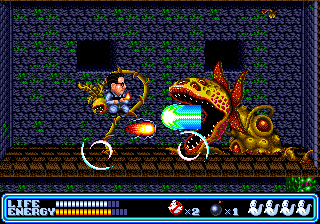 No doubt for most of us the epic words of Ray Parker Jr. still bring about a warm feeling and memories of the joy of youth. Maybe it was the original classic film on a worn-out VHS tape, maybe the Saturday morning cartoon, or maybe the mediocre-but-still-okay sequel. Maybe you even went so far as to buy an old ambulance as your first car in high school. Or maybe you just played the video game on the SMS or Mega Drive like normal people.
No doubt for most of us the epic words of Ray Parker Jr. still bring about a warm feeling and memories of the joy of youth. Maybe it was the original classic film on a worn-out VHS tape, maybe the Saturday morning cartoon, or maybe the mediocre-but-still-okay sequel. Maybe you even went so far as to buy an old ambulance as your first car in high school. Or maybe you just played the video game on the SMS or Mega Drive like normal people.
Last week I went by the old Value Village as usual to check out the electronics section. I had some pretty good scores of Japanese Mega Drive games recently, and I would not be disappointed again. I walked out with a boxed copy of Ghostbusters for the Mega Drive. It wasn’t a game that I had to buy, as I don’t have much time for games these days, but the box really sold me. Looking at the screen caps on the back, it really took me to another time. Suddenly I was a little kid again, trying to make a snap decision in a game store as to whether or not the box was strong enough to make a fun game.
And for some reason, looking at the hilarious sprites with over sized heads, I was certain that my old friends the Ghostbusters wouldn’t let me down. After all, they ain’t scared of no ghosts.
The game did not disappoint. It has been sitting in my Genesis for the last week, and I love it to bits. Say what you will, I think it is one of my favorite Genesis side-scrollers of all time. Even without scaling backgrounds or ninjas. The honest truth is:
Bustin’ makes me feel good.
Master of Monsters By The Coop
Occasionally, you just feel like taking a chance. For some, that involves leaping off of a bridge with what amounts to a giant rubber band strapped to your ankles, or jumping out of a plane with a nylon piece of cloth as the only thing preventing you from being turned into a human-sized Jell-O mold upon impact with the ground. But for those who are a little less adventurous/crazy, taking a chance can involve putting your hard earned cash toward something you’ve never heard of or seen before. And for me, that’s the kind of chance I took one day while visiting a new and used game shop.
It wasn’t a big store, but they set it up so they could cram all sorts of games in. NES, SNES, Master System, and of course, this site’s beloved 16-bitter. I was standing at the shelves, looking over the many Genesis titles that were there in hopes of finding something that interested me. They had used copies of greats like Strider (which I eventually bought from that same store later), Ghouls ‘N’ Ghosts and Phantasy Star II, and those were nestled up against new copies of classics like Sonic The Hedgehog, Revenge of Shinobi and… Master of Monsters.
Wait… what?
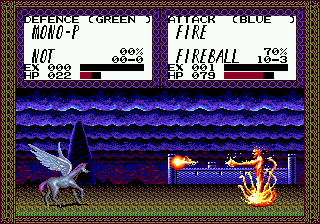 Yes, it was at that little store that I saw Master of Monsters for the first time. At $45 new, it wasn’t something I wanted to jump blindly into, seeing as I’d been stung with the likes of Sword of Sodan and Slaughter Sport before that particular moment. But as I stood there looking over the back of the box, something was tugging at me in the recesses of my mind. I thought, This looks cool. An army of monsters and controlling each one as they fought one on one. I put it back on the shelf and must have come back to it three more times before I finally decided to put faith in that niggling little voice that was telling me, “Get it.”
Yes, it was at that little store that I saw Master of Monsters for the first time. At $45 new, it wasn’t something I wanted to jump blindly into, seeing as I’d been stung with the likes of Sword of Sodan and Slaughter Sport before that particular moment. But as I stood there looking over the back of the box, something was tugging at me in the recesses of my mind. I thought, This looks cool. An army of monsters and controlling each one as they fought one on one. I put it back on the shelf and must have come back to it three more times before I finally decided to put faith in that niggling little voice that was telling me, “Get it.”
I got home and plugged the game in. I was greeted by unexpectedly dramatic and wonderful sounding music. When I began playing, I found myself pausing repeatedly to read the manual for how to make sense of the statistics, how to do various things, and so forth. I will admit that I was quickly disappointed when I learned the monster battles were automated and not manually controlled, but that slowly faded as I dug deeper into the game and got the hang of it. I learned to use the different land types to my advantage, the time of day, long distance attackers against those who couldn’t use a projectile, and soon, I found myself realizing that my taking a chance had paid off.
That was quite a while ago, but I still have Master of Monsters in my collection. I later learned to play piano versions of three of the game’s songs (“Black Dignity,” “Purple Time” and “Into the Deep Blue Sky”), and butted heads many times with the brutal campaign mode. I even got some of my friends hooked on the game as we held three and four player battles that would last a few hours each. It was a little game that came out of nowhere, and vanished almost as quickly. But it was also one that I’m quite thankful I took a chance on that day as I stood loitering in front of that store’s coated-wire shelving.
So while back then, the little voice in my head might not have always lead me to treasure (or stopped telling me to throw away my socks because they were plotting against me), in this instance, it was a treasure that I indeed did find.
Phantasy Star IV By Frank Ramirez
When I was fourteen, I had just completed Final Fantasy III on the SNES, and I was ready for more epic RPG goodness. At the time, VHS and video game cartridge rental stores were at an all time high, and there was no shortage of SNES and Genesis games at my disposal. Perusing the games, I had one of two choices: Breath of Fire II for the SNES, and Phantasy Star IV for the Genesis.
I opted for Breath of Fire II.
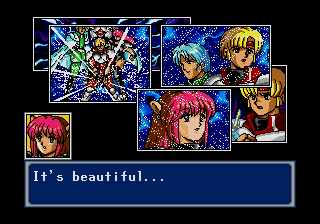 It was a decent play. The translation was… interesting. A bit stilted. Sometimes it just didn’t make a whole lot of sense. I returned it two days later, to never rent it again. I decided that the next time I went back to the rental store, I would DEFINITELY pick up Phantasy Star IV. And why not? There were articles about it in Sega Visions, Gamepro, and Electronic Gaming Monthly. The graphics looked really nice, and the idea of combo spells seemed really cool. And the game must have been in an early stage during the Sega Visions article because “Zio” was referred to as “Jio.” Now at the point, I had NEVER played any previous Phantasy Star games, and assumed it was like Final Fantasy: no ongoing narrative, so I saw no desperate need to go back and play Phantasy Star II or III. I rented it, and took it home, not knowing what to expect.
It was a decent play. The translation was… interesting. A bit stilted. Sometimes it just didn’t make a whole lot of sense. I returned it two days later, to never rent it again. I decided that the next time I went back to the rental store, I would DEFINITELY pick up Phantasy Star IV. And why not? There were articles about it in Sega Visions, Gamepro, and Electronic Gaming Monthly. The graphics looked really nice, and the idea of combo spells seemed really cool. And the game must have been in an early stage during the Sega Visions article because “Zio” was referred to as “Jio.” Now at the point, I had NEVER played any previous Phantasy Star games, and assumed it was like Final Fantasy: no ongoing narrative, so I saw no desperate need to go back and play Phantasy Star II or III. I rented it, and took it home, not knowing what to expect.
It was AWESOME. I’d never played an RPG that leaned more towards sci-fi than fantasy. It was a very nice change of pace. Unfortunately, all good things had to come to an end, and I had to return the game to the store. I didn’t have any extra money to renew it, and I knew with dread that the next time I rented it, my save data would be as good as gone. That’s the problem with internal saves, I guess. It wouldn’t be until a few years later when I was seventeen or so, that I won my very own copy off of eBay for $15, and I finally got to complete the game.
I still have the original cartridge of Phantasy Star IV, as well as on the PS2 on the Sega Genesis Collection, and the Xbox 360 from Sonic’s Ultimate Genesis Collection, which I’m playing at the moment. It’s been a few years since I last played it, but it still holds up pretty well, I think. It has the makings of a great RPG: colorful, detailed graphics, wonderful story, stellar soundtrack (I still get chills from the song “Laughter”), and truly awesome cover art, by the great Boris Vallejo.

Recent Comments